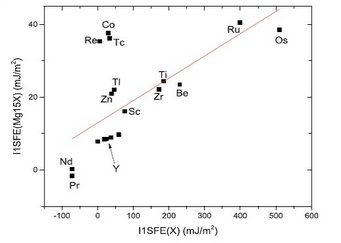Rapid theory-guided prototyping of ductile Mg alloys: from binary to multi-component materials
In order to identify a method allowing for a fast solute assessment without lengthy ab initio calculations, we analyze correlations and anti-correlation between the I1 stacking fault energies (I1 SFEs), which were shown to be related to the macroscopic ductility inMgalloys, and five material parameters of 18 different elemental solutes.

Fig.: Relation between the I1 SFE of Mg X 15 alloy and the I1 SFE of elemental X.
Our analysis reveals that the atomic volume V of pure solutes, their electronegativity ν and bulk modulus B are either linearly or logarithmically related to the I1 SFE. Comparing the impact of solutes with that of yttrium (that increases the ductility in Mg) we propose a single numerical quantity (called yttrium similarity index, YSI) that is based on these interrelations. Subsequently, we evaluate this new figure of merit for 76 elements from the periodic table of elements in search for solutes reducing the I1 SFE. Limiting ourselves first to binary Mg alloys, we hardly find any alternative solutes providing similar I1SFE reduction as that due to rare-earth (RE) additions. Therefore, we extended our search to ternary Mg alloys. Assuming that the physical properties of solute combinations can be represented by their average values, 2850 solute combinations were checked and 133 solute pairs (not including any RE elements) have been found to have a YSI larger than 0.85. Quantum-mechanical calculations have been subsequently performed for 11 solute pairs with YSIs higher than 0.95 and they were all found to reduce the I1 SFE in excellent agreement with the predictions based on the YSI.
